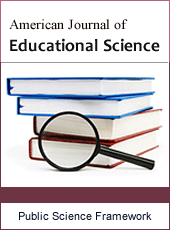American Journal of Educational Science
Articles Information
American Journal of Educational Science, Vol.1, No.3, Jul. 2015, Pub. Date: Jun. 10, 2015
Teaching Arabic for Non-Natives in Jordanian Public Universities: Difficulties and Solutions
Pages: 52-59 Views: 5250 Downloads: 2488
[01]
Bader S. Dweik, Department of English, Faculty of Arts and Sciences, Middle East University, Amman, Jordan.
[02]
Mohammad A. Al-Shallakh, Department of English, Sur University College, Sur, Oman.
This study aimed at investigating the difficulties that non-natives face in learning Arabic at Jordanian Public Universities. It was also an attempt to find some solutions to such difficulties. To achieve these objectives the researchers used a questionnaire which was sent to fifty-three non-native students who learnt Arabic as a foreign language at two Jordanian public universities (i.e. the University of Jordan and Al Al-Beit University). The questionnaire consisted of three areas related to linguistic difficulties, the materials used in teaching and classroom activities. The results obtained by the questionnaire revealed that the existence of different varieties of Arabic constituted a major difficulty. The results also indicated that the materials used in teaching and classroom activities were not helpful for students' to develop communicative competence in Arabic. In the light of these conclusions, different solutions were suggested to overcome these difficulties.
Teaching, Arabic, Non-Native, Difficulties, Solutions
[01]
Abu-Dulbouh, S. (2005). The cultural dimension in teaching Arabic as a foreign language (TAFL).[Unpublished M.A thesis], Yarmouk University, Irbid :Jordan .
[02]
Amayreh, M. (1984). A linguistic analysis and evaluation of Arabic textbooks materials and methodology. [Unpublished doctoral dissertation], Indiana University, Indiana, USA.
[03]
Bell, T. (2005). Behaviors and attitudes of effective foreign language teachers: Results of a questionnaire study. Foreign Language Annals, 38(2), 259-270.
[04]
Dabrowski, M. (2005). Criteria for appraising computer-based simulations for teaching Arabic as a foreign language, [Unpublished doctoral dissertation], Indiana University, Indiana State, USA.
[05]
Dawood, S. (2008) Teaching of the Arabic language in South African schools-nature of the language and methodology, [Unpublished MA thesis], University of South Africa, Africa.
[06]
Dweik, B. (1986). Research papers in applied linguistics. Hebron: Hebron University Press.
[07]
Du,W.(2008). Integrating culture learning into foreign language curricula: An examination of the ethnographic interview approach in a Chinese as a foreign language classroom, [Unpublished doctoral dissertation], The University of Wisconsin –Milwaukee: United States.
[08]
Dweik, B. & Abu-Irmies, A. (2015). Learning Arabic Culture by Speakers of Other Languages. International Journal of Education, Learning and Development. 3 (3), 109-119
[09]
Elkhafaifi, H. (2005). Listening comprehension and anxiety in the Arabic language classroom. The Modern Language Journal, 88, (2), 45-69.
[10]
Fagman, A. & Niman, I. (1996). How to Say it in Arabic? A Project in Teaching Spoken Arabic in Ramot – Hefer High School. Retrieved May 12, 2009 from http://www.ph-ludwigsburg.de/html/9e-aaax-s-01/seiten/SymposiumBB/alon _fragman.pdf
[11]
Faryadi, Q. (2007). Techniques of Teaching Arabic as a Foreign Language through Constructivist Paradigm: Malaysian Perspective. Retrieved April 8, 2009 from: http://www.eric.ed.gov/ ERICDocs/data/ ericdocs2sql/ content_storage_01/0000019b/80/27/ff/69.pdf.
[12]
Gordon, R. (Ed.). (2005) Ethnologic: Language of the world. Dallas, TX: SIL International.
[13]
Husseinali, G. (2006). Who is studying Arabic and why? A survey of Arabic students’ orientations at a major university. Foreign Language Annuals, 2, (39), 395-412.
[14]
Maxos, H. (2002). Arabic for non-natives series-Hussein Maxos: Comparative Studies 1995-2002 IRAMES Group Damascus Retrieved June 26, 2009 from: http://hmaxos.com
[15]
Strout, E. (2006). The challenge of teaching Arabic. Chronicle of Higher Education, 14, (53), 31-51.
[16]
Suliman, A. (2008). The changing role of Arabic in religious discourse: A sociolinguistic study of Egyptian Arabic. [Unpublished doctoral dissertation], Indiana University of Pennsylvania, Indiana State, USA.

ISSN Print: 2381-7127
ISSN Online: 2381-7135
Current Issue:
Vol. 6, Issue 2, June Submit a Manuscript Join Editorial Board Join Reviewer Team
ISSN Online: 2381-7135
Current Issue:
Vol. 6, Issue 2, June Submit a Manuscript Join Editorial Board Join Reviewer Team
| About This Journal |
| All Issues |
| Open Access |
| Indexing |
| Payment Information |
| Author Guidelines |
| Review Process |
| Publication Ethics |
| Editorial Board |
| Peer Reviewers |


